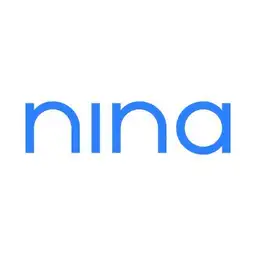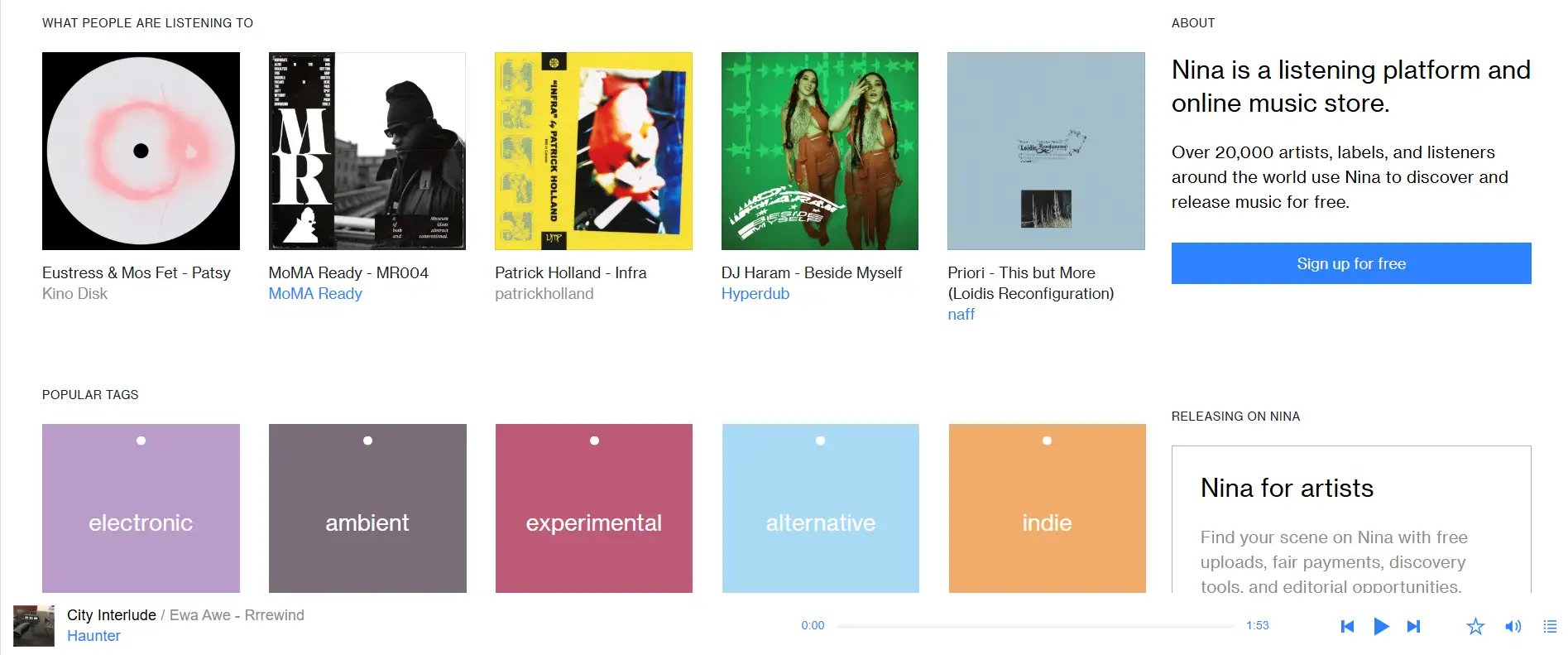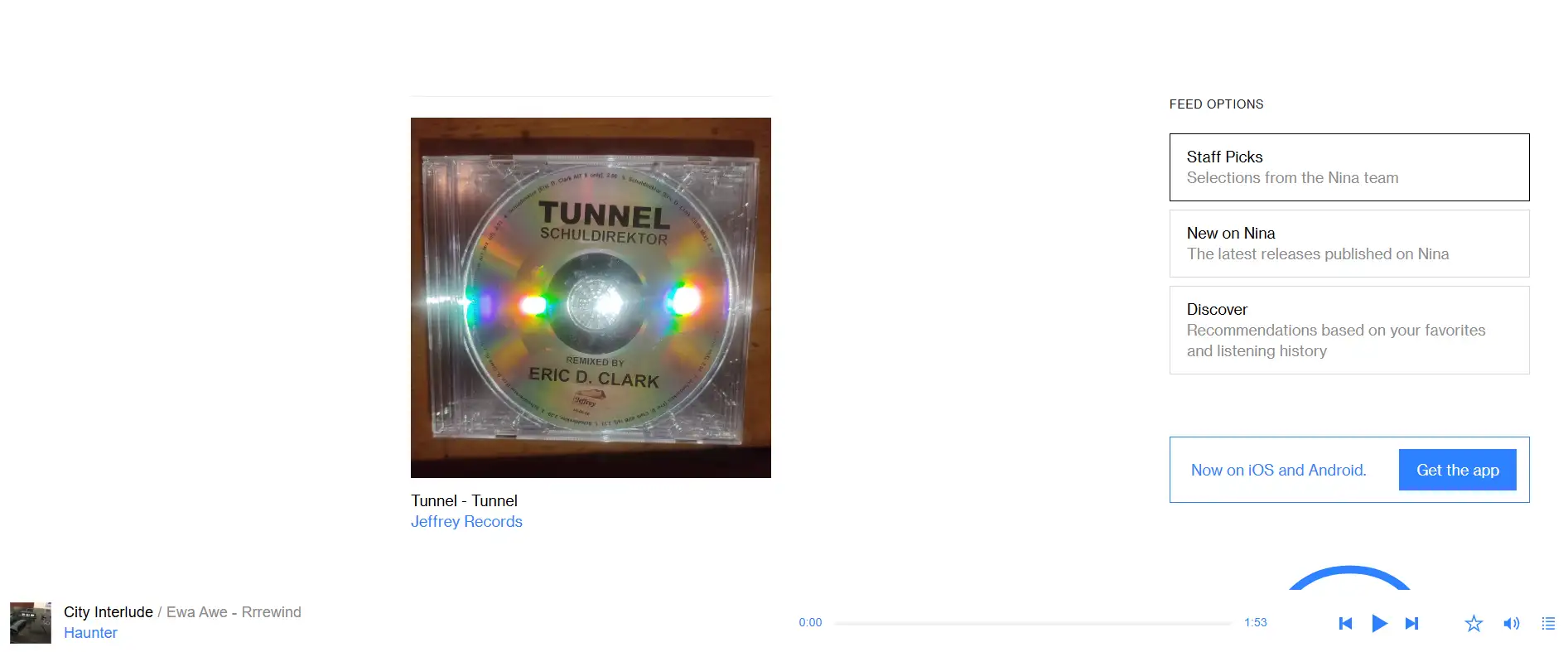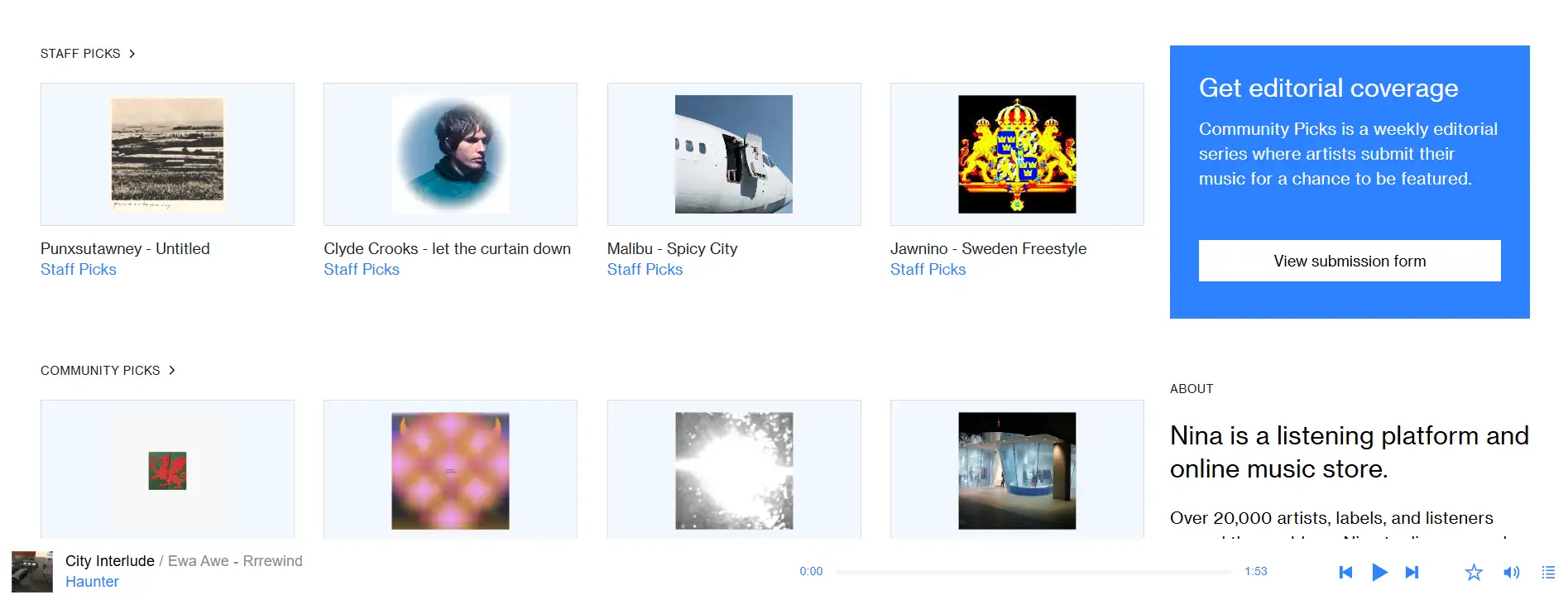About Nina
Nina is a unique Web3-powered music platform and digital record store that allows artists and labels to release, share, and sell their music while retaining full ownership and control. Built for independent musicians and underground communities, Nina enables artists to upload their music, set their own terms, and earn 100% of the revenue from their digital releases. Whether it’s a mixtape, an album, or a sample pack, Nina gives full creative freedom back to its users.
Nina functions as both a listening experience and a decentralized publishing toolkit. With a community of over 20,000 users—including artists, fans, labels, and curators—Nina is redefining how people discover, collect, and support music. Actions like purchases, follows, and uploads are stored on Solana and Arweave, creating a permanent, open, and accessible archive of music activity. Nina is built not for speculation, but for lasting cultural impact in independent music.
Nina was launched with a bold vision: to provide independent artists with a reliable, decentralized, and context-rich alternative to today’s major streaming and music sales platforms. Many musicians today are trapped by exploitative revenue models—receiving fractions of a cent per stream or paying monthly fees just to keep their music online. Platforms like Spotify, Bandcamp, and SoundCloud control content access, earnings, and distribution algorithms. In contrast, Nina empowers artists to break free from those constraints.
Every release on Nina is entirely owned by its creator. No revenue is taken by the platform, and artists can configure the price, availability, and format of their content. Nina supports various release types—albums, singles, sample libraries, type-beats, digital ephemera—and even unlockable "bonus material" such as demos, stems, artwork, or hidden content. This flexibility gives artists the tools to build direct, sustained relationships with their listeners and collaborators without intermediaries.
Unlike most platforms, Nina is powered by open-source protocols and public blockchains, enabling full transparency and long-term permanence. Releases are stored on the Solana blockchain and archived through Arweave, ensuring that music uploaded to Nina is preserved even if the platform itself ceases to exist. Every interaction—whether it’s a follow, purchase, or comment—is on-chain, creating a transparent social graph that other platforms or developers can build upon.
In a time where centralized platforms can change rules, remove content, or reallocate ownership without warning, Nina’s architecture provides resilience and reliability. Artists can run their own storefronts, embed Nina tools into external websites, or integrate their data elsewhere using Nina’s public APIs. It’s a modular, interoperable platform that treats music as a dynamic social object rather than static content on a timeline.
Competitors in this space include Audius, which also offers blockchain-based streaming, and Zora, a protocol for NFTs and cultural objects. However, Nina stands out by rejecting speculative models and focusing purely on the cultural and financial empowerment of independent music communities. Its core strength lies in fostering rich context between artists, labels, listeners, and scenes, rather than relying on algorithms or crypto hype.
The platform also integrates daily editorial features including Q&As, long-form articles, curated playlists, and archival content to highlight the underground scenes it supports. Whether through direct discovery, curated tags, or networked interactions, Nina gives users a wide range of tools to explore music meaningfully. With free streaming, no ads, and full ownership for both artists and collectors, Nina is setting a new standard for how music lives online.
Nina offers a set of unique benefits and features that make it a transformative force in the independent music ecosystem:
- 100% Artist Revenue: On Nina, creators receive the full amount from their digital sales—Nina takes no platform fee. Whether you're a solo artist, label, or archive, your earnings belong entirely to you.
- Blockchain-Backed Permanence: Releases and user interactions are stored on Solana and Arweave, ensuring long-term accessibility even if the platform shuts down. This allows artists to build a lasting digital presence without being dependent on a centralized company.
- Customizable Releases: From albums to digital memorabilia, artists can choose pricing, availability (limited or unlimited), and even attach exclusive bonus material such as demos, stems, artwork, or unreleased music.
- Built-in Collaboration Tools: Artists can define custom splits and automatically distribute earnings between collaborators, streamlining the process of joint releases and ensuring fair compensation.
- No Subscriptions or Ads: Listeners enjoy unlimited streaming for free, without the need for subscriptions or intrusive ads. Payments only occur when someone purchases a release.
- Editorial & Community Discovery: Users benefit from daily editorial content, interviews, curated playlists, and tags that make discovering new scenes intuitive, organic, and deeply context-driven.
- Open Source and Developer Friendly: Nina’s open-source infrastructure allows anyone to integrate its tools into other platforms or build entirely new applications on top of its protocol.
Nina is designed to be easy for both music creators and listeners to use, with minimal friction and full ownership from the start:
- Step 1 – Sign Up: Visit Nina and click “Log in / Sign up.” You can sign in using your email, which will generate a Solana wallet via Magic Link, or you can connect your existing Solana wallet directly.
- Step 2 – Explore the Platform: Browse releases by tag, artist, or label using the powerful search tools. Dive into hubs and editorial content to find new sounds and scenes from around the world.
- Step 3 – Listen for Free: All music on Nina is available for unlimited free streaming with no ads. You only pay if you decide to purchase a release.
- Step 4 – Collect Music: Buy digital releases using your credit card or crypto wallet. Ownership is verifiable on-chain, and you'll gain access to any attached bonus material from the artist.
- Step 5 – Upload & Sell (For Creators): Artists can upload tracks, define pricing, attach exclusive content, and set automatic revenue splits with collaborators. Nina gives you total flexibility and zero platform fees.
- Step 6 – Share & Build Community: Connect with other artists and listeners, curate playlists, and follow your favorite labels. Nina is designed to be both a music platform and a cultural network.
- Step 7 – Dive into Editorial: Check out the Editorial section for Q&As, curated recommendations, and write-ups about emerging artists and genres.
Nina FAQ
Nina operates on completely different principles than platforms like Bandcamp or SoundCloud. It’s built on open-source and decentralized infrastructure, meaning that artists keep 100% of their revenue and retain total ownership over their work. There are no subscription fees, no platform cuts, and no algorithms manipulating visibility. Nina is not just a streaming service—it’s a toolkit for self-publishing and building context-rich relationships between artists, labels, and listeners.
Bonus material on Nina allows artists to offer supporters access to exclusive digital content. These can include lossless audio files, demo tracks, stems, sample packs, liner notes, artwork, zines, or even experimental digital objects. It gives creators the flexibility to expand their artistic offering and reward collectors with more than just music.
Yes. Nina is designed for usability by anyone, regardless of their technical background. You can sign up using just an email, which automatically creates a Solana wallet via Magic Link. You can also pay with a credit card—no crypto required. All blockchain functions (ownership, payments, storage) happen in the background, giving users the benefits of Web3 without the complexity.
Because Nina stores all content and metadata on Solana and Arweave, your releases and purchases are preserved permanently—even if the Nina interface is no longer online. Artists can access their music and payment logic through public blockchains, and developers can build new platforms that reuse the data. It’s one of Nina’s key advantages: decentralized music that outlives the platform itself.
Nina doesn’t rely on algorithms to recommend content. Instead, it fosters community-based discovery through editorial coverage, curated tags, scene-specific hubs, and direct relationships between artists and listeners. Users can create playlists, follow labels, read in-depth interviews, and explore emerging scenes through Nina’s editorial. It’s built to reflect how underground communities actually share and grow music culture.
You Might Also Like












